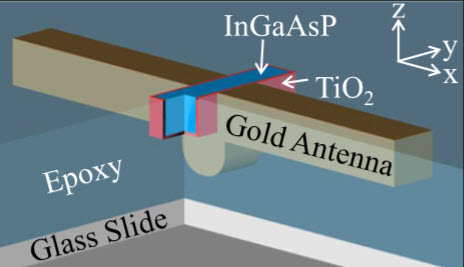Replacing lasers with LEDs for short-range optical communications
February 6, 2015

Antenna-enhanced spontaneous emission from Indium Gallium Arsenide Phosphide nanorods (credit: Michael S. Eggleston et al./PNAS)
Berkeley Lab researchers have developed a nano-sized optical antenna that can greatly enhance the spontaneous emission of light from atoms, molecules and semiconductor quantum dots.
That opens the door to light-emitting diodes (LEDs) that can replace lasers for short-range optical communications, including optical interconnects for microchips and a host of other potential applications.
“Since the invention of the laser, spontaneous light emission has been looked down upon in favor of stimulated light emission” (as in lasers), says Eli Yablonovitch, an electrical engineer with Berkeley Lab’s Materials Sciences Division. “However, with the proper optical antenna, spontaneous emission can actually be faster than stimulated emission.”
Boosting light emitted by doped nanorods
Yablonovitch led a team that used an antenna made from gold to effectively boost the spontaneous light emission of a nanorod made from Indium Gallium Arsenide Phosphide (InGaAsP) by 115 times. This is approaching the 200-fold increase that is considered the landmark in speed difference between stimulated and spontaneous emissions. When a 200-fold increase is reached, spontaneous emission rates will exceed those of stimulated emissions.
“With optical antennas, we believe that spontaneous emission rate enhancements of better than 2,500 times are possible while still maintaining light emission efficiency greater than 50 percent,” Yablonovitch says. “Replacing wires on microchips with antenna-enhanced LEDs would allow for faster interconnectivity and greater computational power.”
In the world of high technology lasers are ubiquitous, the reigning workhorse for high-speed optical communications. Lasers, however, have downsides for communications over short distances (one meter or less): they consume too much power and take up too much space. LEDs would be a much more efficient alternative but have been limited by their spontaneous emission rates.
Creating an optical antenna
“Spontaneous emission from molecular-sized radiators is slowed by many orders of magnitude because molecules are too small to act as their own antennas,” Yablonovitch says. “The key to speeding up these spontaneous emissions is to couple the radiating molecule to a half-wavelength antenna. Even though we’ve had antennas in radio for 120 years, somehow we’ve overlooked antennas in optics. Sometimes the great discoveries are looking right at us and waiting.”
For their optical antenna, Yablonovitch and his colleagues used an arch antenna configuration. The surface of a square-shaped InGaAsP nanorod was coated with a layer of titanium dioxide to provide isolation between the nanorod and a gold wire that was deposited perpendicularly over the nanorod to create the antenna. The InGaAsP semiconductor that served as the spontaneous light-emitting material is a material already in wide use for infrared laser communication and photo-detectors.
In addition to short-distance communication applications, LEDs equipped with optical antennas could also find use in photodetectors, imaging, bio-sensing, and data storage applications.
The open-access results of this study are reported in the Proceedings of the National Academy of Sciences (PNAS).
Yablonovitch also holds a faculty appointment with the University of California (UC) Berkeley where he directs the NSF Center for Energy Efficient Electronics Science (E3S), and is a member of the Kavli Energy NanoSciences Institute at Berkeley (Kavli ENSI).
This research was supported by E3S, the U.S. Air Force Office of Scientific Research, and the U.S. Department of Energy’s Office of Science.
Abstract of Optical antenna enhanced spontaneous emission
Atoms and molecules are too small to act as efficient antennas for their own emission wavelengths. By providing an external optical antenna, the balance can be shifted; spontaneous emission could become faster than stimulated emission, which is handicapped by practically achievable pump intensities. In our experiments, InGaAsP nanorods emitting at ∼200 THz optical frequency show a spontaneous emission intensity enhancement of 35× corresponding to a spontaneous emission rate speedup ∼115×, for antenna gap spacing, d = 40 nm. Classical antenna theory predicts ∼2,500× spontaneous emission speedup at d ∼ 10 nm, proportional to 1/d2. Unfortunately, at d < 10 nm, antenna efficiency drops below 50%, owing to optical spreading resistance, exacerbated by the anomalous skin effect (electron surface collisions). Quantum dipole oscillations in the emitter excited state produce an optical ac equivalent circuit current, Io =qω|xo|/d, feeding the antenna-enhanced spontaneous emission, where q|xo| is the dipole matrix element. Despite the quantum-mechanical origin of the drive current, antenna theory makes no reference to the Purcell effect nor to local density of states models. Moreover, plasmonic effects are minor at 200 THz, producing only a small shift of antenna resonance frequency.